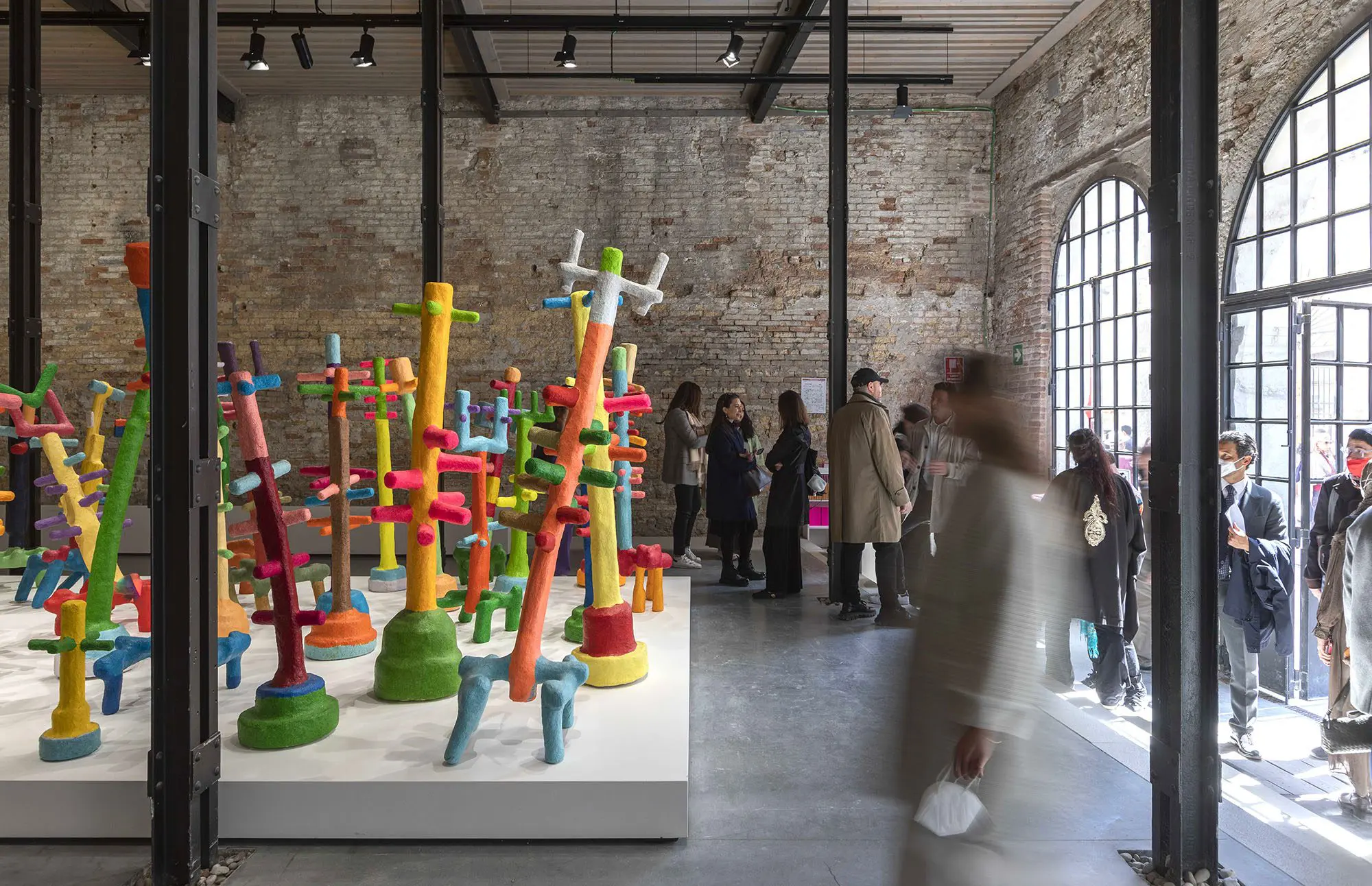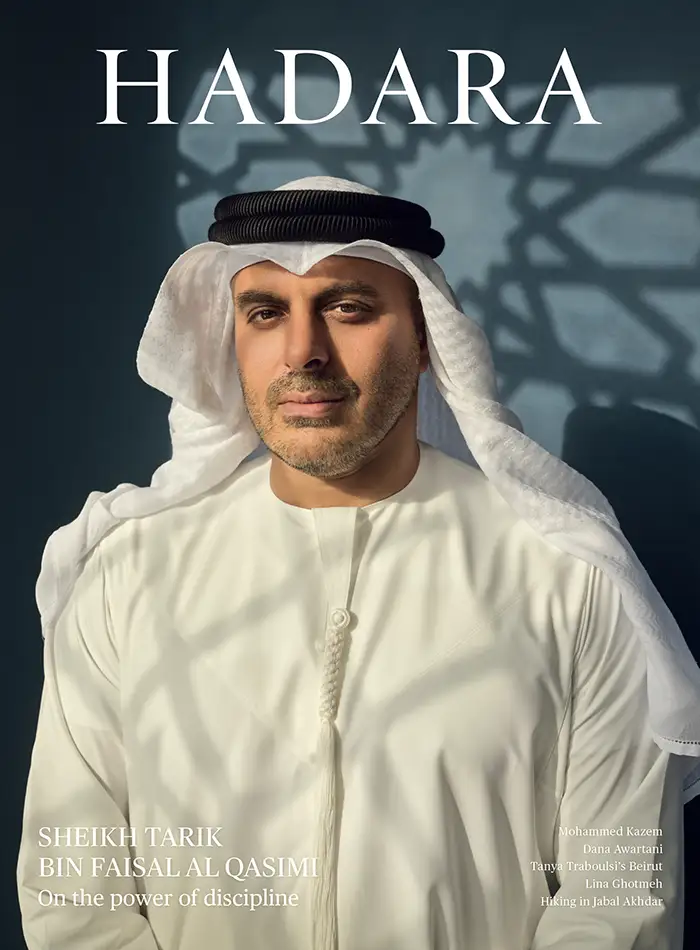A Porous Practice
One of the most prolific artists in the UAE, Mohamed Ahmed Ibrahim crafts his work in the mountains of Sharjah’s Khorfakkan and represents his nation at this year’s Venice Biennale.
By Anna Seaman
How do you encapsulate more than four decades of work of one of the most quietly prolific artists in the UAE? This was the dilemma facing Maya Allison, curator of the National Pavilion of the United Arab Emirates at this year’s Venice Biennale.
To allow the viewer to focus on the experiential aspect of Mohamed Ahmed Ibrahim’s work, Allison asked for a single piece, but a complex one, both sculptural in form yet porous in meaning and in character.
Between Sunrise and Sunset, a collection of 128 human-sized sculptural elements, populates the UAE Pavilion in Venice’s former shipyard district, the Arsenale. The elements ask for “a non-verbal comprehension,” Allison says. “This is the largest piece [Ibrahim] has ever made and it is not something you can really explain. You have to experience it to understand it. It is our hope that this will open up curiosity and other perspectives on the people and the landscapes of the UAE.”
It took Ibrahim two years to make the brightly coloured, bulbous and biomorphic forms. He used raw papier-mâché, incorporating rough texture with grass, dirt, and leaves coming from Ibrahim’s regular forages into the mountains that surround his home studio. He also used tea, coffee, and tobacco—staples in the artist’s almost-reclusive atelier. The sculptures have been called abstract and even land art because of their reference to the landscape in which Ibrahim was born.
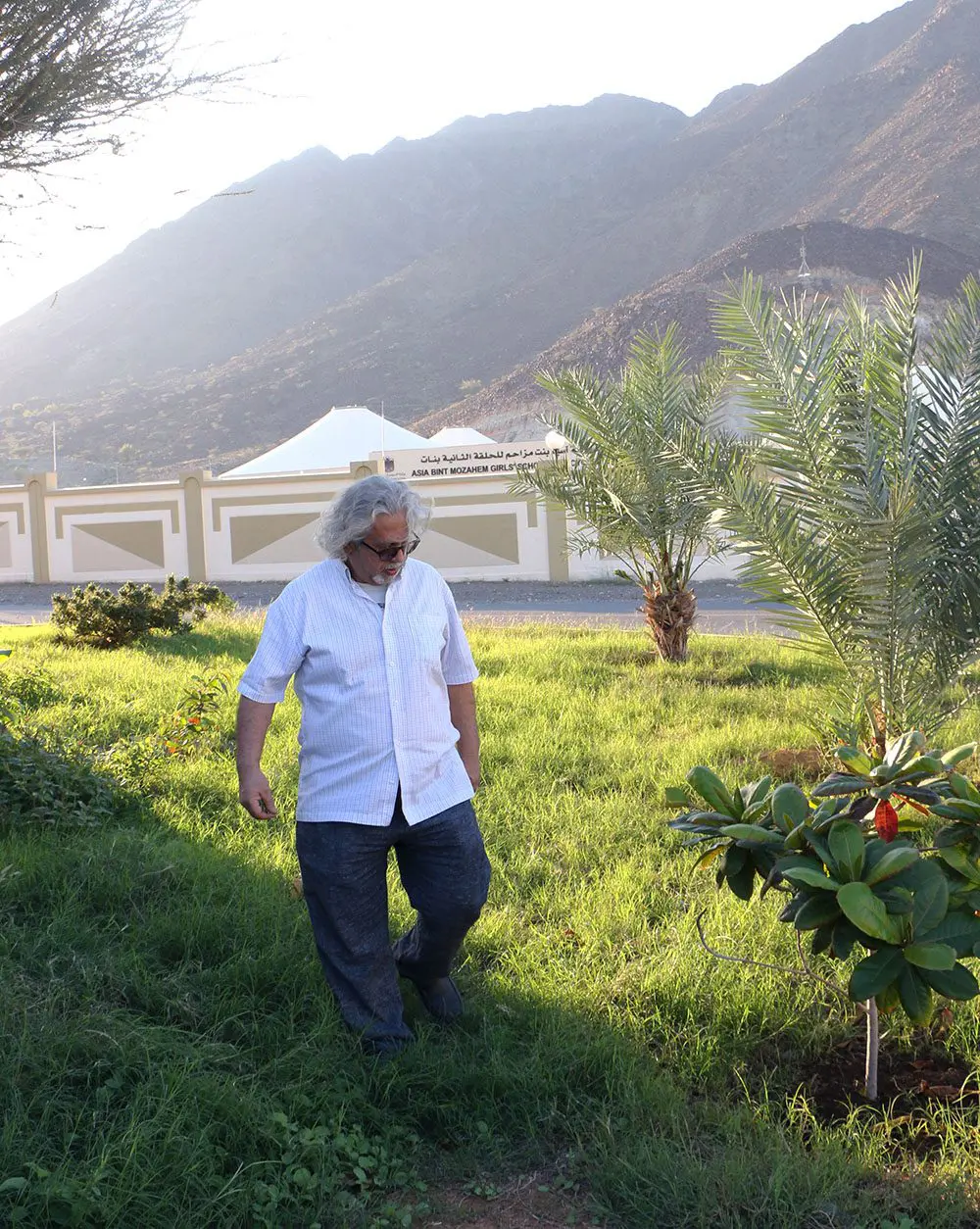
MOHAMED AHMED IBRAHIM: BETWEEN SUNRISE AND SUNSET, opening image, is a room-filling sculptural form made up of 128 abstract and organic elements. The exhibition is inspired by the artist’s deep connection to the physical environment of his hometown, Khorfakkan, on Sharjah’s east coast.
“I always like to give the viewers an open invitation to interpret my work as they like. I don’t want to frame any ideas,”
However, they are neither one nor the other. “His work doesn’t fit easily into one category or another,” Allison says. “He sources material from his environment, which happens to be a really dramatic landscape, so then the shorthand becomes land art, even though obviously the sculptures are not land art.” Nor are they really abstract, Allison muses. Instead, she sees them as systems and process-based art, but even then definition is elusive. This is the heart of Ibrahim’s success as an artist. Be it sculptural, painting or drawing, he portrays shapes that resemble something familiar but are also indescribable.
“I always like to give the viewers an open invitation to interpret my work as they like. I don’t want to frame any ideas,” Ibrahim says. “Someone can see these sculptures as figures, whereas for someone else they are animals, plants, or flowers. Everyone is right. It is actually most interesting for me when children see my work; they are freer in their expression.”
Human subjectivity informs Ibrahim’s practice, perhaps stemming from his earlier studies of psychology at Al Ain University (class of 1986). All readings of the work are valid, and it is his ability to speak to a primordial part of the viewer that brings a deep connection.
Previous works and exhibitions have continually tackled this subject. A solo show, Primordial, ran at Cuadro Gallery in Dubai in 2014. After switching his gallery to Lawrie Shabibi, in the city’s Alserkal Avenue, his other shows have also probed the workings of the subconscious mind. As Ibrahim shapes his thoughts about artworks and later turns those thoughts into forms, he looks to patterns made by absent-minded doodling or the swirling lines and abstract symbols that flash up between the eyelid and the eyeball. Through this meditative and almost unthinking process, he has created his own visual language, which is simultaneously unique and universal.
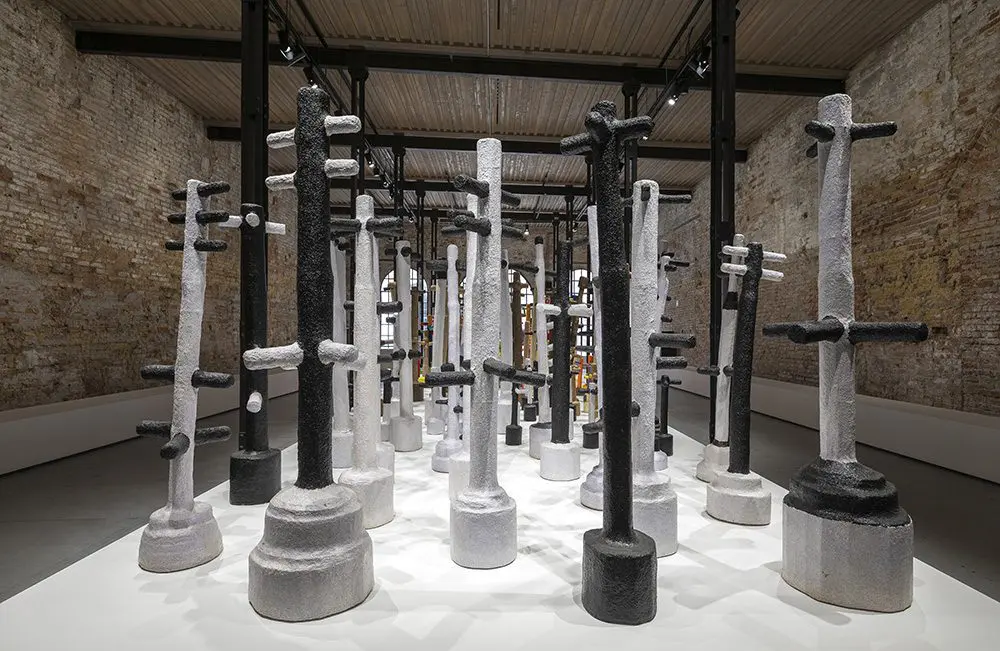
The title of the exhibition refers to the artist’s experience of light in Khorfakkan, where mountains cast the town in afternoon shade. The sculpture shifts from bright playful colours and forms to subdued black and white elements.
“I think that part of his training as a psychologist has fed into how he frames his work and his understanding of the viewers’ experience of the art,” Allison says. “By allowing the subjectivity of whatever psychological state you are in to come to the work, that will be reflected in what you’re going to find in the work.
“He also talks a lot about the memory drum,” Allison continues, “which is an access to pre-language memories and is definitely something that was part of his training in psychology.”
In psychological literature, memory drum is a theory that unconscious neural patterns acquired from past experiences are stored in the central nervous system within a memory storage organ. Ibrahim, fascinated by this and by his sense that children have an innate knowledge beyond conventional communication, made a series titled Memory Drum in 2020 during lockdown, which resulted in his previous exhibition.
This deeper dive into the working of human memory and language, combined with his career-long obsession with colour, culminated in the presentation in Venice. As well as being a meditation upon the mind’s inner workings, his work for Venice is also an homage to the land.
The title, Between Sunrise and Sunset, is a direct reference to the artist’s use of bright, almost garish colours. Growing up in Khorfakkan, a small enclave on Sharjah’s east coast that is flanked by mountains on three sides, Ibrahim didn’t see the sun set until he visited Kuwait at the age of six. These early memories of spending afternoons cast in a grey, washed-out shadow have continued to play an important role for him, even as he turns 60.
The tension between Khorfakkan’s colourful mornings, when the sun rises over the ocean, and the disappearance of colours in mid-afternoon is also the cyclical journey that Allison wanted for the viewer during the curation of her piece.
“The theme that we agreed—Between Sunrise and Sunset—has an implicit reference to the landmass of the UAE, because the UAE has the sunrise on one side and sunset on the other, but it is also a reference to the movement of light across Khorfakkan,” she explains.
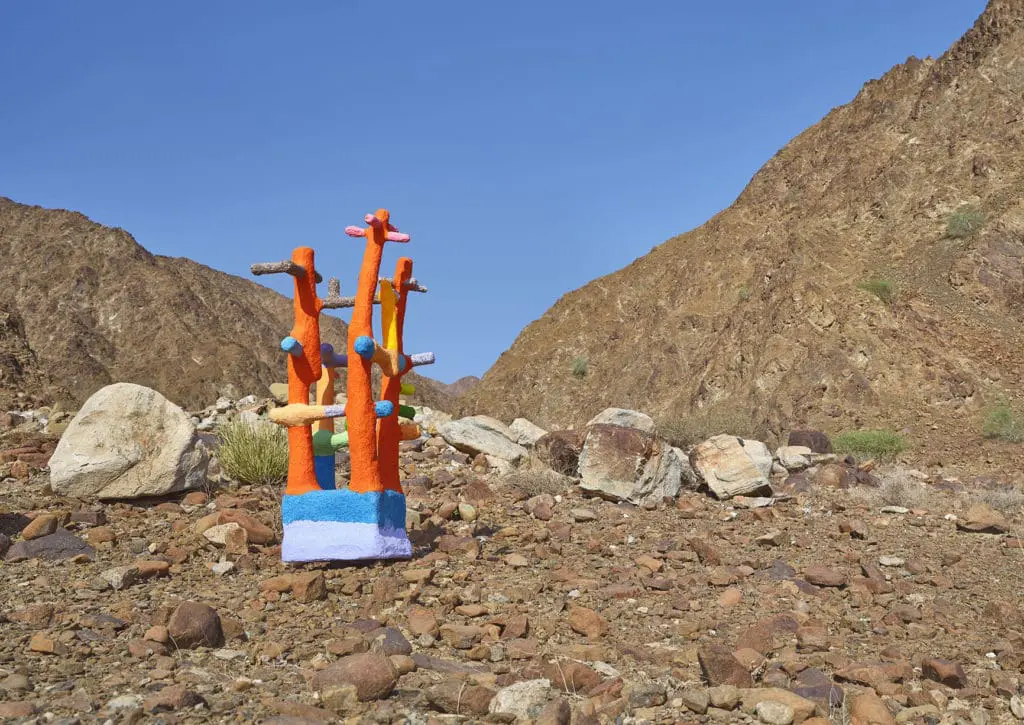
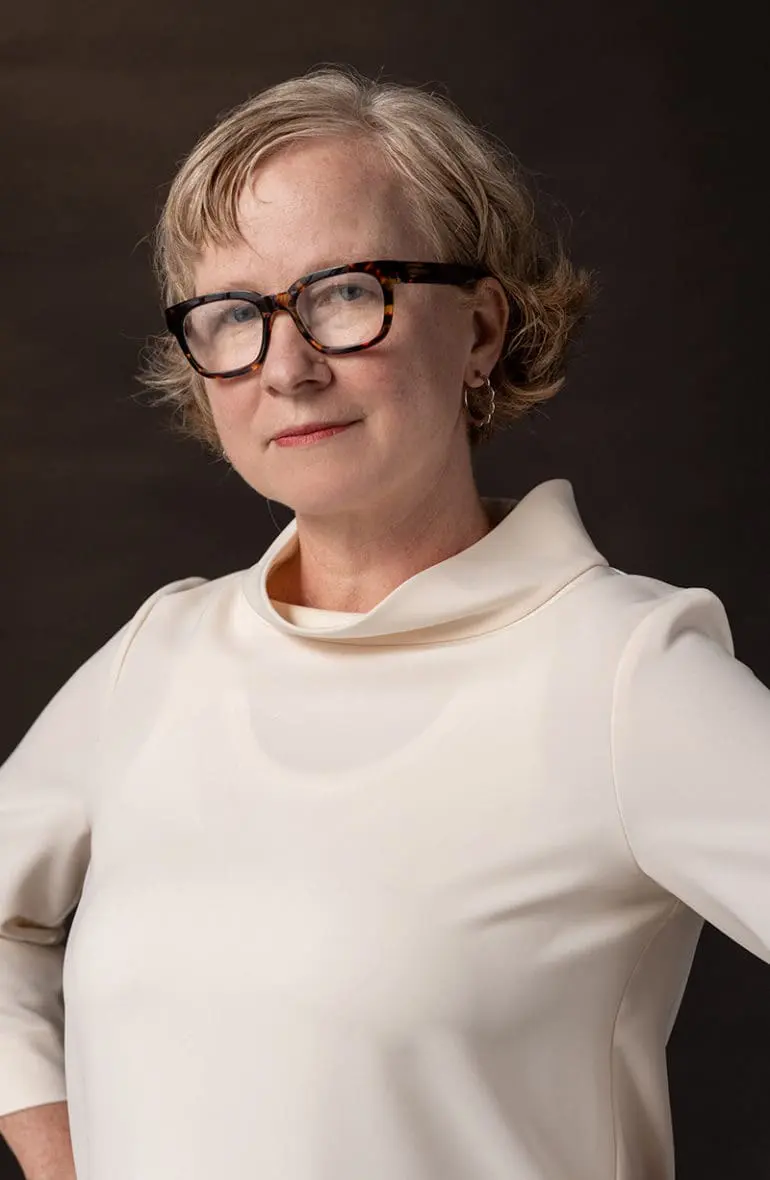
Maya Allison, curator of the UAE National Pavilion and executive director of NYU Abu Dhabi Art Gallery. The work was created from raw papier-mache and natural materials such as dirt, leaves, tea, coffee and tobacco.
However, such is the nature of Ibrahim’s work that the art piece itself carries with it a kind of porous ability to adapt to any environment it is in.
“Nothing is straight in Venice; all the walls are crooked and the old buildings seem to move as if the whole city is a boat. And when we took Mohamed’s work there it just naturally adjusted to it; it almost came to life, like it knew that’s where it was supposed to be going. It really does sort of take on its own personality in that context,” says Allison, who is also executive director of the New York University Abu Dhabi Art Gallery.
In that way, Between Sunrise and Sunset melds fluidly with the theme of the Biennale: The Milk of Dreams. In her curatorial statement, Cecilia Alemani suggests this title to indicate magical fantasy, bodies and metamorphosis. Ibrahim’s work teeters between imagination and reality, uses corporality and fuses it with fantasy and, as Allison notes, can metamorphose into any environment, making it the perfect fit for this event.
THE EVOLUTION OF THE NATIONAL PAVILION
The selection of Ibrahim to represent the UAE in Venice signals a maturity to the national pavilion, which is now in its second decade. The pavilion professes to an artist-led practice—Ibrahim nominated his own curator—allowing a more natural and organic presentation to develop. At the opening ceremony in April, Noura Al Kaabi, the UAE’s Minister of Culture and Youth, called Ibrahim a “convention-defying artist.”
The national pavilion is shaping the UAE’s cultural landscape by realising Ibrahim’s work process through this exhibition, said Angela Migally, executive director of the Salama bint Hamdan Al Nahyan Foundation which commissioned the pavilion. “This exhibition is testament to our commitment to invest in the UAE’s art ecosystem, spearheading the growth and understanding of [its] creative community. Extraordinary artists like Ibrahim deserve global recognition.”
Photography Credits: “Between SunRise and Sunset” (2) by Ismail Noor of seeing things / National Pavilion UAE La Biennale Di Venezia; Ibrahim by Cheb Moha; John Varghese / Desert art courtesy of National Pavilion UAE La Biennale Di Venezia; maya Allison by Mohamed somji of seeing things / National Pavilion UAE La Biennale Di Venezia.
Middle Eastern artists make a mark in Venice
Unsettling works that worry about the future fit well into the Biennale’s theme of surrealism.
By Charles Shafaieh
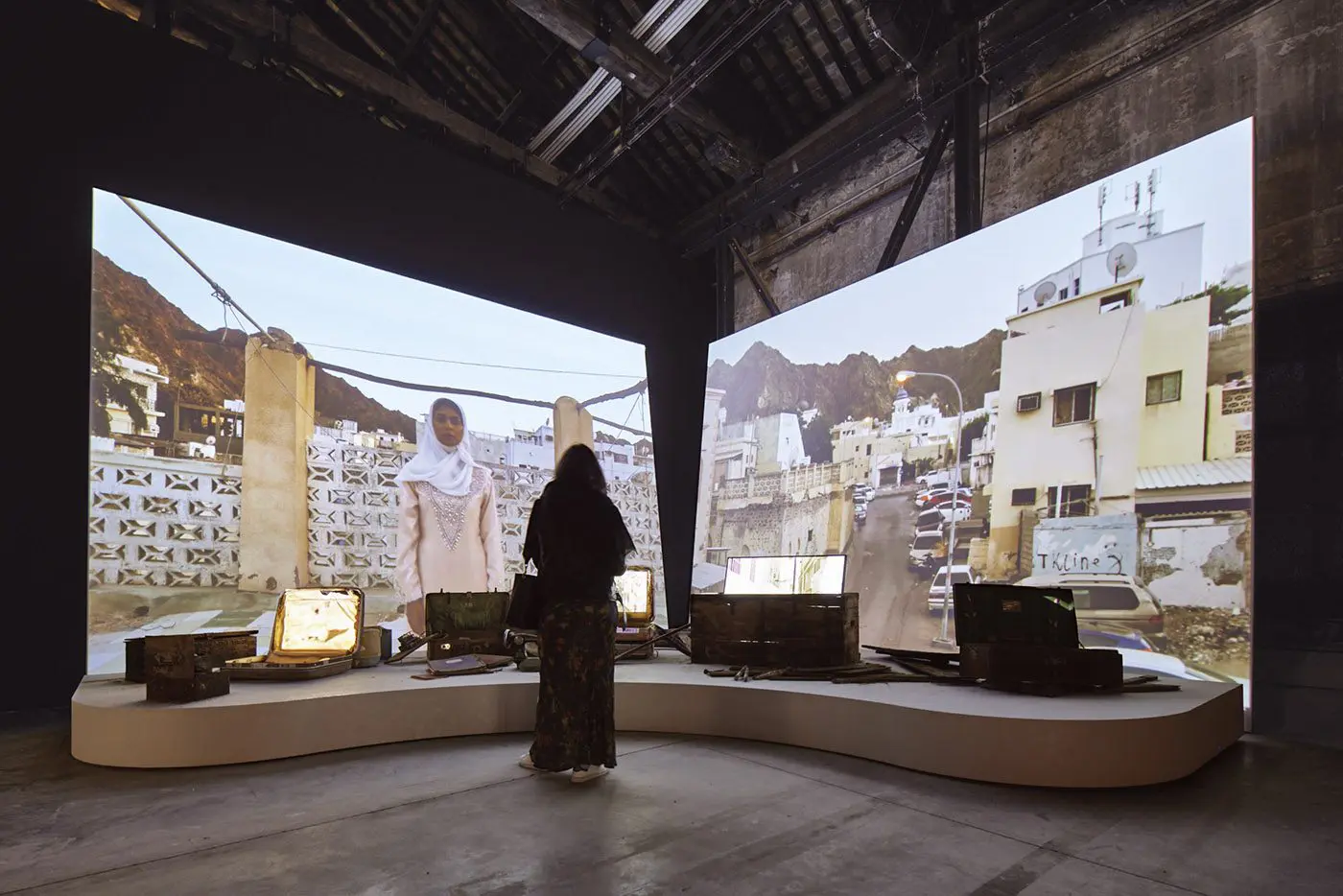
REFLECTIONS FROM MEMORIES by Hassan Meer. An installation consisting of found objects from houses in the old town of Muttrah, Oman.
Surrealism is centre stage at the 59th Venice Biennale, which began in April and continues through November 27. The exhibition’s title, The Milk of Dreams, is borrowed from a children’s book by artist Leonora Carrington (1917–2011). Curator Cecilia Alemani chose Carrington’s work for its focus on the imagination—its inclination towards wild, unpredictable transformations and, in turn, its ability to expand how we understand ourselves and the world around us.
Metamorphosis, the evolving relationship between humans and nature, the impact of technology on life, and how we define “human” are among the themes engaged by the Biennale’s over 200 participants. The numerous MENA artists present speak to these ideas in ways which address their specific cultures as well as universal concerns.

THE TEACHING TREE A 40-metre-long structure made of palm fronds by Saudi artist Muhannad Shono.
Oman, with its own pavilion for the first time, showcases the scope of its art scene by bringing together new works by five artists spanning three generations. Speed of Art is a poignant collaboration between Anwar Sonya, a pioneering artist active since the 1970s, and Raiya Al Rawahi, who developed a proposal for the piece before her death from cancer, at 30, in 2017. On a screen inserted within an abstracted cross-section of an airplane fuselage—a ruin as well as a shelter—Sonya delivers an impassioned monologue from the future in which he rails against robots taking over cultural production. He passionately praises humans for skills that machines cannot replicate.
This becomes an uneasy soundtrack to Budoor Al Riyami’s Breathe nearby. An homage to the Al Hajar mountains, the installation includes five totemic sculptures made to resemble peridotite, an igneous rock, that seemingly hover midair. The rocks, plentiful in Oman, interest climate-change scientists because of their carbon-capture potential. What first appear like shadows underneath these spectacular boulders are actually resin “screens” that hold a cautionary tale about human intervention in nature. Projected deep within their oily surface, short videos of hands manipulating these stones, sometimes violently, foreshadow the rocks’ disintegration and, as a result, maybe human life as we know it.
Resilience in the face of destruction is the subtext to the Lebanese pavilion in an adjacent room. Lebanon’s appearance in Venice despite an economic crash, political turmoil, and the Beirut port explosion is a testament to its art community’s vitality. The space, designed by Aline Asmar d’Amman, evokes the country’s notable Brutalist architecture. Its curved concrete walls pull visitors together as they engage two works which address the difficulty of daily life in Beirut. Danielle Arbid’s Allo Chérie, a two-channel video, turns a seemingly banal journey through the city by the artist’s mother into an emotional search for money.

DREAMS HAVE NO TITLES Zineb Sedira presents an immersive installation consisting of film, sculpture, photography, sound and collage.
Directly across the room, the cityscape visible in Arbid’s work is made material, in distorted form, in Ayman Baalbaki’s mixed-media installation Janus Gate. One side is a kaleidoscopic collage of the panels that cover construction sites, neon signs, floral wallpaper, and debris, all splattered with technicolor impasto. The other side, a military “watchman room” setting, carries none of this vibrancy. The entire exterior around the hut is painted the olive-green of army fatigues, from the garments hanging on clotheslines to a tea kettle and table. Conversely, the cramped interior glows crimson, as if viewed through a rifle’s night scope. The world perceived through the lens of war. Unclear which side represents past and future, the vibrant, chaotic, and unsettling work examines a precarious city in flux.
Riyadh-based Muhannad Shono, the sole artist at the Saudi Arabia pavilion, pushes further into abstraction with his monumental Teaching Tree. The 40-metre-long work continues his long-term exploration of the line as the fundamental facet of aesthetic creation. Made of palm fronds dyed jet-black and assembled by hand in the kingdom, the fluid, almost tentacular sculpture appears to snake through the room. Resembling as much a mark of Arabic calligraphy as a bird’s wing or the tail of a mythical beast, it also subtly moves, through the use of concealed pneumatics. It pushes against the confines of the room and even wraps itself around the metal pillars supporting the ceiling. At once natural and artificial, knowable yet fantastical, this strange object appears both welcoming and terrifying, as its sharply pointed “tail” seems poised to strike. While consciously emblematic of the rebirth of Saudi Arabia’s cultural sector, it also evokes enigmatic and primitive aspects of human consciousness and the natural world.

JANUS GATE Ayman Baalbaki’s unsettling, three-dimensional, mixed-media installation.
Diaspora communities are represented throughout Venice as well, most notably by Zineb Sedira, the first French-Algerian artist invited to exhibit at France’s pavilion. Born in 1963 to Algerian parents in Gennevilliers, outside Paris, she now lives in London. Such cultural hybridity is a focus of her large-scale installation Dreams Have No Titles, which received one of the Biennale’s special recognition awards. The piece looks at the ways in which film, as a medium, can function as a tool for colonial control as well as for liberation, influence the formation of individual and collective identities, and trouble clear-cut definitions of nationhood.
At its centre is a nostalgic recreation of a Gennevilliers cinema showing a film by Sedira that is as much autobiographical as it is an examination of film history. In part a celebration of Algerian avant-garde cinema from the 1960s and ’70s, it utilises actual footage and recreations of scenes from Algerian co-productions with Italy and France—a clear nod both to Venice and to Sedira’s heritage. Of particular importance is Ennio Lorenzini’s documentary Les mains libres (1964), the first feature film made in independent Algeria, which was lost for decades until Sedira discovered it in a film archive in Rome and spearheaded its restoration. The rest of the pavilion is turned into a film studio recreating sets quoted in her film, from an Algerian wooden bar and dance floor to a facsimile of Sedira’s own living room. In these “fake” settings, visitors write their own stories as they are invited to dance or make her “home” their own. The experience further blurs the separation between reality and fiction explored in her film and throughout this surrealist-inspired Biennale.
From top: the sultanate of oman pavilion; Samuele Cherubini, Courtesy of The Artist and The Visual Arts Commission, Saudi Arabia; Thierry Bal and Zineb Sedira; Federico Vespignani / LVAA

